
Setting a Shared Folder
Windows-standard SMB/CIFS technology is used for sending files to shared folders. SMB/CIFS is a protocol for sharing resources, such as files and printers, with more than one device in a network (Configuring SMB).
 |
|
You can register a set shared folder to the Address Book so it can be specified as a destination for scanning to (Registering Address Book from Remote UI ).
|
Windows Server 2003/Server 2003 R2/Server 2008/Vista/7/Server 2008 R2/8/8.1/Server 2012/Server 2012 R2
It is recommended that you consult the administrator for the network you are using when configuring the file server.
The number of users or clients that can access a server running Windows Server 2003/Server 2003 R2/Server 2008/Vista/7/Server 2008 R2/8/8.1/Server 2012/Server 2012 R2 is limited. After this number of users or clients is reached, it is not possible to send to a server running Windows Server 2003/Server 2003 R2/Server 2008/Vista/7/Server 2008 R2/8/8.1/Server 2012/Server 2012 R2.
In the following procedures, items displayed on the screens for Windows Vista/8 are used. Depending on your environment, the items you see on the screen may differ.
The number of users or clients that can access a server running Windows Server 2003/Server 2003 R2/Server 2008/Vista/7/Server 2008 R2/8/8.1/Server 2012/Server 2012 R2 is limited. After this number of users or clients is reached, it is not possible to send to a server running Windows Server 2003/Server 2003 R2/Server 2008/Vista/7/Server 2008 R2/8/8.1/Server 2012/Server 2012 R2.
In the following procedures, items displayed on the screens for Windows Vista/8 are used. Depending on your environment, the items you see on the screen may differ.
1
Log on to Windows with administrator privileges.
2
Display the window for setting the network connection.
Windows Server 2003: From the [Start] menu, select [Control Panel] - [Network Connections].
Windows Vista/Server 2008: From the [Start] menu, right-click [Network]  select [Properties]
select [Properties]  click [Manage network connections].
click [Manage network connections].
 select [Properties]
select [Properties]  click [Manage network connections].
click [Manage network connections].Windows 7/Server 2008 R2: From the [Start] menu, right-click [Control Panel]  select [Network and Internet]
select [Network and Internet]  click [Network and Sharing Center].
click [Network and Sharing Center].
 select [Network and Internet]
select [Network and Internet]  click [Network and Sharing Center].
click [Network and Sharing Center].Windows 8/8.1/Server 2012/Server 2012 R2: Place the cursor on the top right (bottom right) of the desktop  select [Settings]
select [Settings]  [Control Panel]. Select [Network and Internet]
[Control Panel]. Select [Network and Internet]  click [Network and Sharing Center].
click [Network and Sharing Center].
 select [Settings]
select [Settings]  [Control Panel]. Select [Network and Internet]
[Control Panel]. Select [Network and Internet]  click [Network and Sharing Center].
click [Network and Sharing Center].3
Click the [Connections] local area network name  Click [Properties].
Click [Properties].
 Click [Properties].
Click [Properties].If you are using Windows Server 2003/Server 2008/Vista, right-click the [Local Area Connection] icon  select [Properties].
select [Properties].
 select [Properties].
select [Properties].If you are using Windows 7/Server 2008 R2, click [Local Area Connection]  [Properties].
[Properties].
 [Properties].
[Properties].4
Select [Client for Microsoft Networks], [File and Printer Sharing for Microsoft Networks], and [Internet Protocol (TCP/IP)]/[Internet Protocol Version 4 (TCP/IPv4)].

5
Double-click [Internet Protocol (TCP/IP)]/[Internet Protocol Version 4 (TCP/IPv4)].
6
In the [Internet Protocol (TCP/IP) Properties]/[Internet Protocol Version 4 (TCP/IPv4) Properties] dialog box, click [Advanced] on the [General] sheet  click the [WINS] tab.
click the [WINS] tab.
 click the [WINS] tab.
click the [WINS] tab.7
On the [WINS] sheet, select [Enable NetBIOS over TCP/IP].
8
Click [OK] repeatedly to close the dialog box.
9
Restart the computer if prompted.
10
Confirm the computer name.
11
Set the user and password for accessing the shared folder.
|
1
|
Display the window for managing the computer.
Windows Server 2003: From the [Start] menu, right-click [My Computer]
 select [Manage]. select [Manage].Windows Vista/Server 2008/7/Server 2008 R2: From the [Start] menu, right-click [Computer]
 select [Manage]. select [Manage].Windows 8/8.1: Right-click on the start screen
 select [All apps]. Right-click [Computer] or [This PC] select [All apps]. Right-click [Computer] or [This PC] select [Manage]. select [Manage].Windows Server 2012/Server 2012 R2: Place the cursor on the bottom left of the desktop and right-click
 select [Computer Management]. select [Computer Management]. |
|
2
|
Double-click [Local Users and Groups] for [System Tools] in the [Computer Management] window.
If you are using Windows Server 2008/Server 2008 R2, double-click [Configuration] under [Server Manager].
|
|
3
|
Right-click the [Users] folder
 click [New User]. click [New User].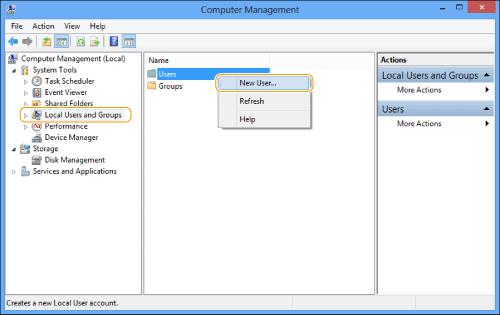 |
|
4
|
In the [New User] dialog box, enter the user name in [User name]
 enter the password in [Password] enter the password in [Password]  reenter the password in [Confirm Password] reenter the password in [Confirm Password]  click [Create]. click [Create].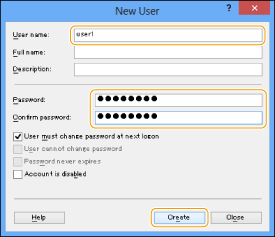 Enter a user name not longer than 20 alphanumeric characters, and a password not longer than 32 alphanumeric characters.
If you select [User must change password at next logon], any new users added must change their passwords in order to send data from the machine. (You cannot change the password from the control panel.)
|
|
5
|
Close the [Computer Management] window.
 In the Active Directory environment, the procedures for setting up users differ from the above. For more information, see the Windows manual.
When a computer that one or more users log on to is restricted by the administrator in an Active Directory environment, the name of the computer must be registered in the Active Directory. Set the computer name in the user account properties dialog box to "CANON + the last 8 digits of the MAC address of the computer + 00". For example, if the MAC address of the computer you are using is "00:00:11:22:33:44", set "CANON1122334400".
|
12
Select the folder to share in Windows Explorer, etc.  right-click the folder
right-click the folder  select [Properties].
select [Properties].
 right-click the folder
right-click the folder  select [Properties].
select [Properties].13
Enter the share name.
If you are using Windows Server 2003:
|
1
|
On the [Sharing] sheet, select [Share this folder]
 enter the share name in [Share name]. enter the share name in [Share name]. |
|
2
|
In the [Computer Management] window, right-click [Computer Management (Local)]
 select[Properties]. select[Properties]. |
If you are using Windows Vista/Server 2008/7/Server 2008
R2/8/8.1/Server 2012/Server 2012 R2:
|
1
|
On the [Sharing] sheet, select [Advanced Sharing].
|
|
2
|
Select [Share this folder]
 enter the share name in [Share name]. enter the share name in [Share name].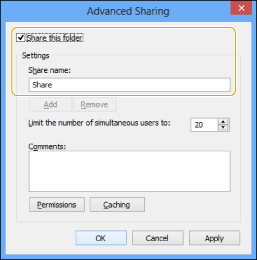 |
14
Set permissions.
To create a shared folder on a FAT or FAT32 format disk (If the [Security] tab is not displayed):
|
1
|
Click [Permissions].
|
|
2
|
In the dialog box that appears, select or add the users or groups to whom you want to give access to the shared folder
 in the list for setting the access permissions, select [Allow] for both [Change] and [Read] in the list for setting the access permissions, select [Allow] for both [Change] and [Read]  click [OK]. click [OK]. |
To create a shared folder on an NTFS format disk:
|
1
|
Click the [Security] tab.
|
|
2
|
Select the users or groups to whom you want to give access to the shared folder
 click [Add]/[Edit] click [Add]/[Edit]  in the list for setting the access permissions, set [Allow] for access permissions [Write] and [Read & Execute] or higher. in the list for setting the access permissions, set [Allow] for access permissions [Write] and [Read & Execute] or higher.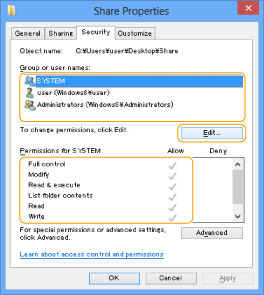 For data in the folder, check [Allow] for both [Write] and [Read], or a higher access authority.
 In the Active Directory environment, the procedures for specifying the security settings of the shared folder differ from above. For more information, see the Windows manual.
|
|
3
|
Click [OK].
|
Mac OS X 10.6
 |
|
When changing your computer's settings, it may be necessary to unlock the computer by clicking the key icon.
|
1
Log in to Mac OS X as an administrator.
2
Set the user and password for sending the data.
|
1
|
From Dock or the apple menu, select [System Preferences]
 [Accounts]. [Accounts]. |
|
2
|
In the [Accounts] window, enter the name of the user to whom you want to send data from the machine through Mac OS X
 enter the password. enter the password.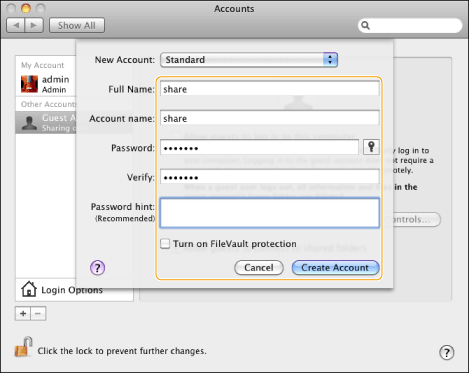 |
|
3
|
Click [Show All] on the toolbar.
|
3
Start the SMB service on Mac OS X.
|
1
|
Click [Sharing] in the [System Preferences] window.
|
|
2
|
Select [File Sharing]
 click [Options]. click [Options].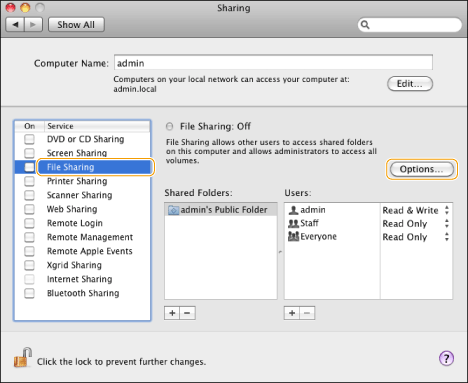 |
|
3
|
Select [Share files and folders using SMB (Windows)].
|
|
4
|
Select the account to be used.
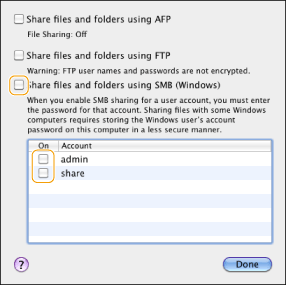 |
|
5
|
Enter the account password
 click [OK] click [OK]  [Done]. [Done]. |
4
Create a shared folder to which files are to be sent.
Sample setting:
Create a folder named "SMB_Folder" (customizable) in [Go] - [Home] - logged in user name - [Public] - [Drop Box].
Create a folder named "SMB_Folder" (customizable) in [Go] - [Home] - logged in user name - [Public] - [Drop Box].
5
Set the access permissions for the shared folder created in step 4.
|
1
|
With the shared folder selected, click [Get Info] from the [File] menu.
|
|
2
|
Display [Sharing & Permissions].
|
|
3
|
Allow Read/Write for [Privilege].
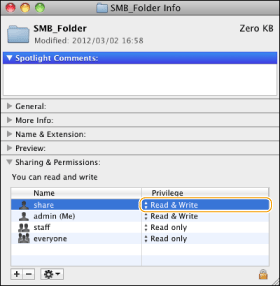 |
Samba (UNIX/Linux)
Samba 2.2.8a or later is supported.
In some environments, detailed settings may be required in order to use the Samba. For details, consult the administrator for the network you are using.
In some environments, detailed settings may be required in order to use the Samba. For details, consult the administrator for the network you are using.
1
Set up the users who access the Samba shared folder, and their passwords.
Log in to a workstation as a superuser  set the user name and password.
set the user name and password.
 set the user name and password.
set the user name and password.Enter a user name and a password no longer than 32 alphanumeric characters.
 |
|
If you are using Windows Vista, a dialog box may appear while you are performing the procedure. In this case, enter a user name and password. For more information, see the manuals provided with the operating system.
|